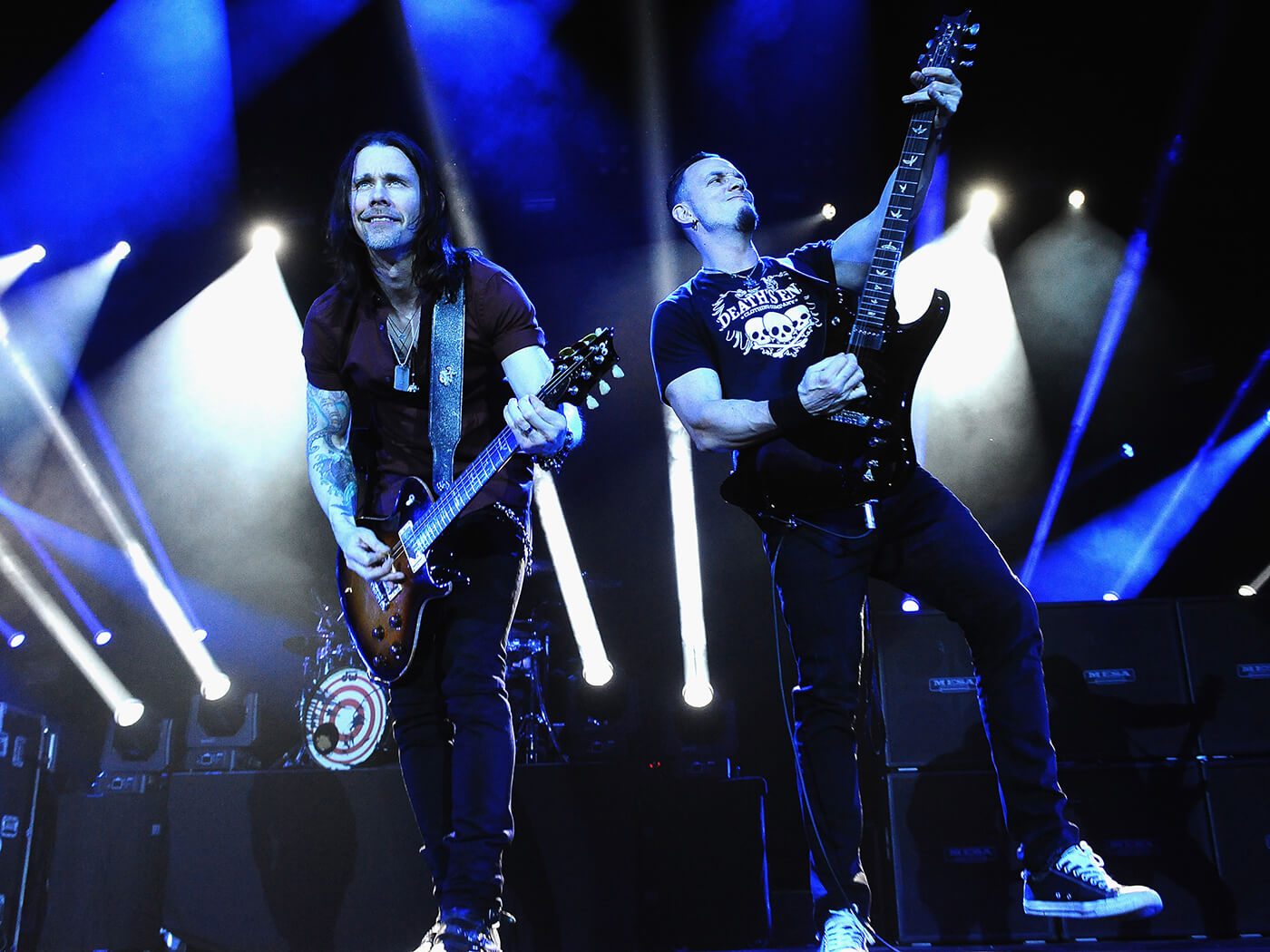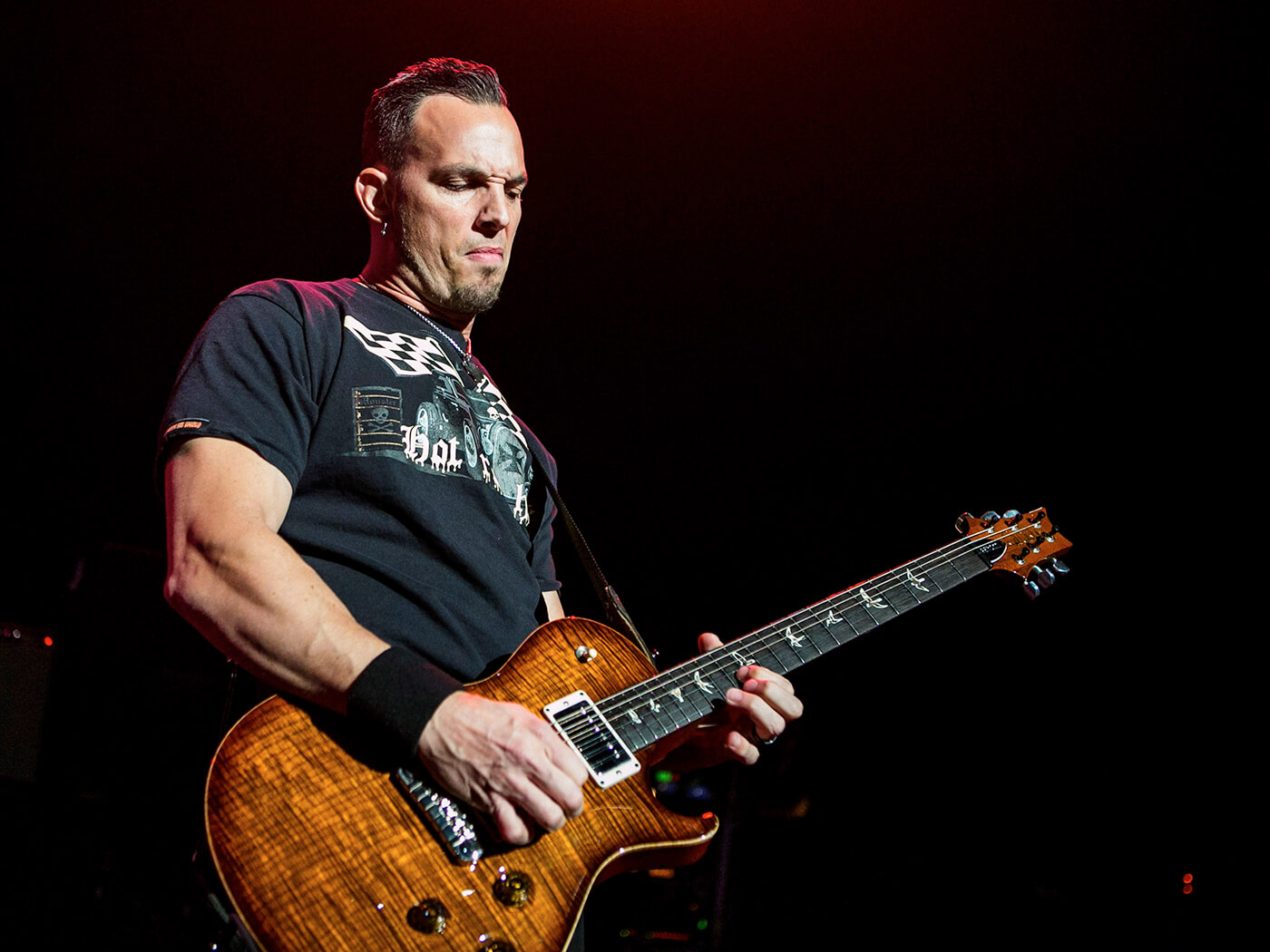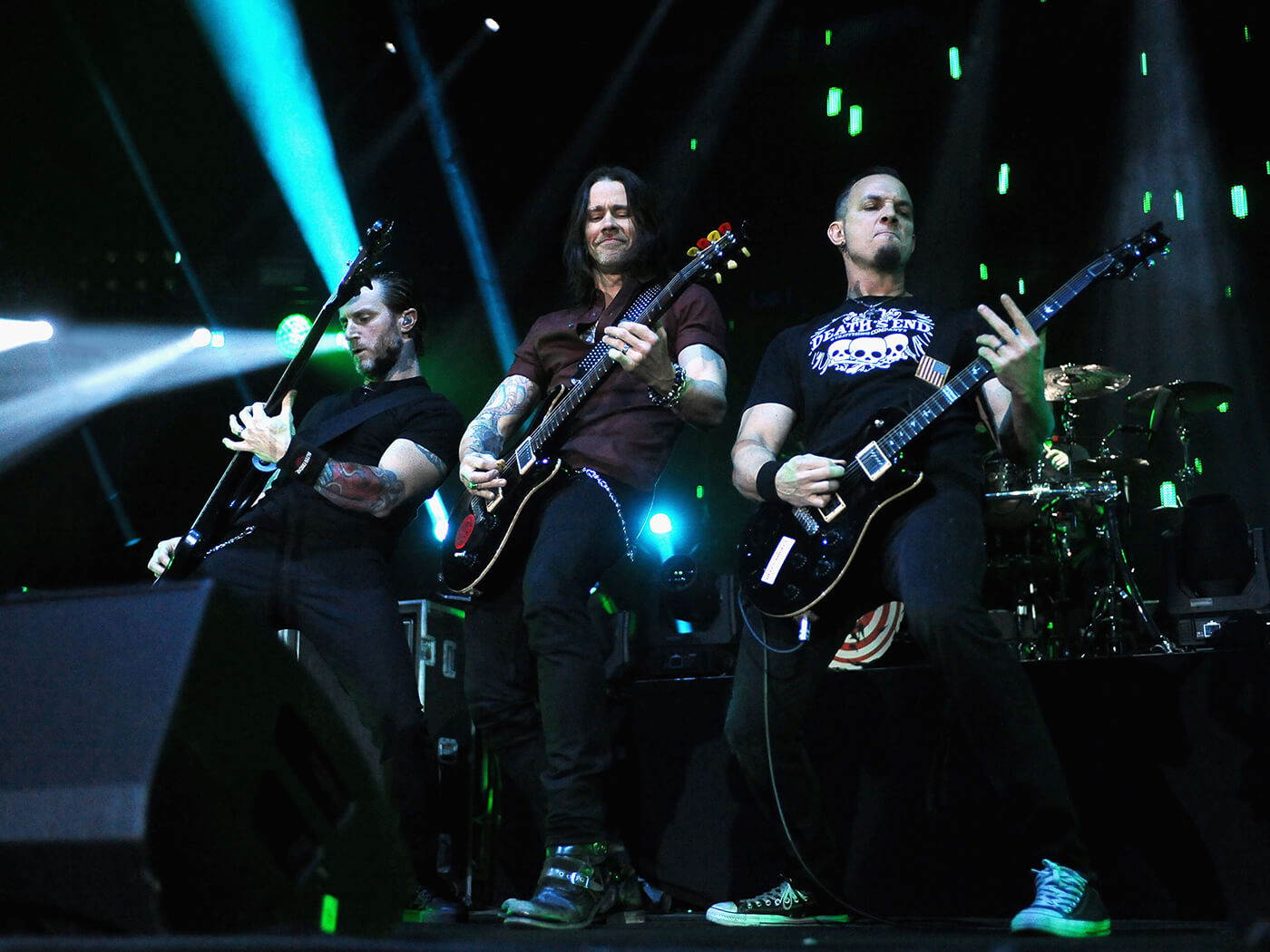“The last thing I wanted to do was bring the acoustic; I just wanted to rock”: Alter Bridge’s Myles Kennedy
Myles Kennedy and Mark Tremonti break down the restrained process behind Walk The Sky, from getting rid of guitar cabinets to being inspired by movie soundtracks.

Image: Roberto Serra – Iguana Press / Redferns
Alter Bridge have come a long way from their debut One Day Remains. When we meet to discuss their sixth album, Walk The Sky, Tremonti admits he didn’t even realise his frontman, Myles Kennedy, was a guitar player until they started finalising their debut album.
Since their certified gold first album was released back in 2004, Tremonti and Kennedy have become a somewhat formidable writing partnership. Four albums followed, all of which have landed in the top five of the UK rock charts and received widespread critical acclaim. Their newest musical offering, the aforementioned Walk The Sky, almost brings the band back full circle, with Tremonti and Kennedy opting to develop songs and ideas separately for the first time since One Day Remains, as opposed to collaborating with the guidance of their long-time producer Michael “Elvis” Baskette.
“I don’t know if it would work out as well had we done it 10 years ago” Kennedy admits. “I think that we’ve been in the groove creating so much in this band, and other entities, where the creative muscles have been flexed and utilised for so long that everything just fires quicker and we really learned to trust our instincts on our own. I learned to trust my knee jerk reaction with an initial idea and just kind of see it through to the point where it can at least be demoed and then turned over to the collective effort.”
The catalyst behind this reworked form of writing was arguably forced upon the band, due to the availability and sheer demand on both members. Indeed, Alter Bridge’s recent albums have been sandwiched between session work and solo projects for both Kennedy and Tremonti. The former has seen his stock shoot up in recent years through his work alongside The Conspirators with Slash – where he’s contributed to three studio albums – and last year saw the release of his first solo outing, an unexpected offering of roots-inspired acoustic songs utilising resonators and lap steel guitars. Year of the Tiger was composed as a concept album, revisiting the death of Kennedy’s father in 1974.
Meanwhile Tremonti also found time to release his fourth studio album, A Dying Machine, under his solo moniker. Also working under the premise of a concept album, it was accompanied by a novel co-written by Tremonti and American sci-fi writer John Shirley, aiming to tie together the loose ends of the album’s plot.
Their collective engagements resulted in songs they wouldn’t have written as a pairing, giving their sixth LP a new lease of life. What did light a fire under their seats though, was the time constraints put on the recording sessions.

Tremonti admits it was pressure they weren’t used to, but actually drove them on to finish the album. “We knew we had to hit the ground running in the studio. We had five to six weeks of everything – pre production, recording, tracking and getting everything done. First it was a little nerve wracking. But once we got the ball rolling, I think it worked out to our benefit. I think that initial pressure was actually good because if we had all the time in the world… I’ll do it tomorrow!”
“Our producer and unofficial fifth member of the band is Michael ‘Elvis’ Baskette, and if things were looking grim, you’d get the phone call and he’s saying ‘look, bro…’” Kennedy chuckles, “there was always plenty of incentive to work.”
Stranger things
Walk The Sky was launched with two characteristically mammoth tracks in Wouldn’t You Rather and Pay No Mind. While Wouldn’t You Rather opens with Alter Bridge’s trademark riffery and tightness, it’s preceded on the record by an album opener which is almost entirely composed of synthesizers. Pay No Mind opens in a similar vein, with eighties-inspired Juno sounds leading the charge before detuned guitars enter the fold.
“I’m not a massive fan of synth stuff in rock and roll but I loved it when synths just came about,” Tremonti says, revealing that their influences for this album cycle came from movie soundtracks, rather than their rock peers. “I think those were the coolest sounds. Like when you watch the movie The Warriors or something. The synth layers in that are creepy, they’re cool, they’re not so polished.”
But the band are keen to point out they weren’t trying to reinvent themselves here, instead aiming to incorporate something new and unexpected of them. Or, alternatively, it’s just the result of binge-watching a certain Netflix show. “Stranger Things!” Kennedy interjects. “I remember the thing that really struck me about that series was the intro. There’s a certain nostalgia there but there was something about that approach to the synth that was very eerie to me. I thought, ‘How could you utilise this in the context of a rock band?’”
Kennedy’s epiphany came into fruition when he was introduced to the British synth band Gunship by Tremonti, where he heard textures reminiscent of John Carpenter movies and the Stranger Things soundtrack. Once the legwork had begun on LP number six, Tremonti admits there was some initial retaliation to the degree in which they were leaning on electronic instrumentation. “When I was listening to some of the initial mixes I kind of gave a little pushback. I thought we might be going overboard with the with the synth stuff, but then he’s [Michael Baskette] like, ‘That’s not synth, that’s Myles’s guitar part!
“That’s not saying that I didn’t like the part I just didn’t want to have the record completely take 180 and do the whole synth thing. A lot of stuff that you might think is a synth is a Myles guitar part with the Electro-Harmonix Synth 9.”
Whilst the introduction of a more modern approach to composing is a welcome addition on this album, we’re also intrigued by the influence of the band’s extra-curricular work we alluded to earlier.

Myles Kennedy is one of the most revered singers in rock music, but it’s not necessarily his work with Slash that impacted his sonic direction for Walk The Sky. “For me the biggest thing that affected this record was having the opportunity to write a solo record [Year of the Tiger] right before the last Slash record, which was acoustic. I was so ready to rock, I was so hungry to play the guitar and riff out. That kind of cleansed my sonic palette. Frankly, the last thing I wanted to do was bring the acoustic to this, I just wanted to rock.”
Tremonti reveals that his latest solo escapade allowed him to develop more confidence in his work, without the need to bounce ideas off his peers and bandmates. “Being able to do something on your own from start to finish, before demoing it for everybody else, you just gain more confidence.
“You get to the point where your mailman comes and drops something off and you’re like ‘Do you like this idea or that idea?’ You need somebody to bounce stuff off. You do your stuff individually and then know that in the end it’s going to be better when everyone else puts their heads together.”
Despite Mark Tremonti’s former band being tagged a Christian act, that hasn’t deterred Alter Bridge from visiting spiritual topics on their albums. Their 2010 album AB III didn’t shy away from visiting darker lyrical territory, particularly on songs such as Slip to the Void. What is apparent on Walk The Sky is Kennedy’s more enlightened prose, which he credits to “the idea of discovering age old writings, concepts and really philosophies, a lot of which came from Eastern philosophies.”
“I found that certainly really made sense to me and helped me frame my own existence and things that I’d really struggled with for a really long time. One Life is kind of the antithesis to what we did on Slip to the Void on AB III. Am I enlightened? No. But do I feel like I’m on a much healthier path? Absolutely.”
In with the old
Although the band has made a conscious effort to push their sonic boundaries on their sixth release, their loyalty to the work of Paul Reed Smith remains steadfast. Tremonti was one of the first artists to receive a signature model from PRS, but still remains a gearhead at heart. “I play Stratocasters and Telecasters, Gretsches and whatever else at home just to stay inspired and to keep my mind open to different tones. I’ve even told the folks at PRS if I’m going to sit down and play a Stevie Ray Vaughan song, it’s got to be on a Strat.”
Despite his affinity for both modern metal guitars and vintage Fenders, Tremonti’s real passion lies with amplifiers. “I feel like when you sit down in a room and plug into a different amp every half hour or so it’s like the setting puts you in a different mood. Just like painting with a different colour, it brings different styles out of you.”
His collection includes a multitude of amps from Dumbles to Mesa Boogie Rectifiers, Mezzabarbas to a ’59 high-powered tweed Fender Twin. The mainstay throughout this album cycle, alongside hs tried and trusted Cornford RK100, was his new signature the PRS MT15.
“It’s a marriage between a Fender Twin, a Mesa Boogie Rectifier and a Bogner Uberschall. It’s got a nice, smooth singing lead with a punchy rhythm tone and a very nice fingerstyle tone. I’m honest when I say when I go home, I plug into that. And when I’m when I’m writing, it brings the most out of me. If I had that amp as a kid for five or six hundred bucks, I would have wet myself!”

Kennedy is also a tried and true PRS player, noted for his use of McCartys and his beloved SC245. Despite that, he laughs when we query the announcement of his signature model.
“Here’s my problem; I’m so scattered with guitars, what I gravitate towards and what inspires me at any given point. It moves so much I’m afraid to be tethered to one thing. You know on this record most of the things that I wrote were all written on a Telecaster.
“Elvis has got a bunch of the new Gibson Les Paul’s, it was a ’59 body with a ’58 neck and ’57 guts. and that guitar really works for my approach. For most of my leads I used that guitar.”
Amp wise, Kennedy has remained a Diezel connoisseur for the majority of his career. “Mark uses a lot of real estate with his sound so finding an amp setup that sits in the pocket took a long time. The Herbert was the amp live but on this record I’d say 70% of what you’re hearing is actually the VH4.”
As a band that’s personified by its use of dropped and alternate tunings, particularly C# and D5, it’s surprising to hear that Kennedy opted to record all of his guitar parts without the depth and bottom end of 4×12 cabinets on this record, instead opting for the Universal Audio The Ox. “The Universal Audio Ox, it’s all about that on this record! I don’t think you hear any cabinets at least on my side. I��’ve got two of them now, that’s what you’re going to hear live. I don’t even know if I’m gonna need a cabinet.”
Tremonti quickly interjects “we’ll take his cabinets and put them on my side!”
Walk The Sky is out now on Napalm Records.
